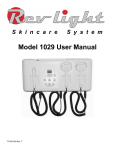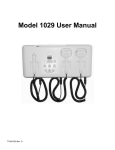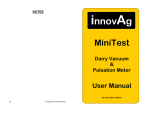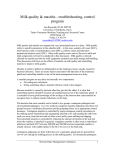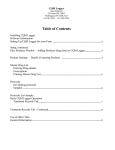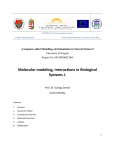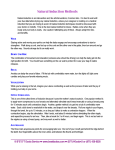Download Milking System Troubleshooting
Transcript
Milking System Troubleshooting Inadequate vacuum or vacuum fluctuation may have several possible causes: • the vacuum pump is too small; • restricted airflow in vacuum or pulsation line; • sticky vacuum regulator; • worn vacuum pump belt; • air leaks in vacuum system due to cracks, poorly sealed junctions or broken components; • vacuum lines or milk lines too small; High system vacuum level may be due to: • vacuum regulator out of adjustment; • sticky vacuum regulator. Reasons for pulsators operating too fast or too slow may include: • pulsators out of adjustment; • if pneumatic pulsators, system vacuum may be incorrect; • pulsators may be dirty, air inlet constricted; • worn pulsators may need repair or replacement. The main cause of teat cup drop-off is low claw vacuum level. Check for the following: • low system vacuum; • milk pipeline too high; • vacuum pump capacity inadequate for number of milking units; • plugged claw or teat cup air inlets; • air leaks in pipeline couplings, valves, junctions, air tubes. If milking times become extended, check milking times for a number of cows on each milking unit. If slow milking is a problem for all cows at all milking units, check for: • low system vacuum; • pulsator controller out of adjustment – pulsation rate too slow or pulsation ratio too low. If slow milking occurs at specific milking units only, check for: • pulsator out of adjustment – pulsation rate too slow or pulsation ratio too low; • cracked and leaking long vacuum tube or short vacuum tubes; • plugged claw or teat cup air inlets; • cracked and leaking teat cup liners. ... continued Milking System Troubleshooting (continued) The following may be causes of incomplete milk removal: • inadequate premilking stimulation for maximum oxytocin release; • delay in attachment of cluster after preparation; • early removal of cluster; • teat cup ‘crawl’ caused by excessive teat-end vacuum level; • cow in heat; • stray voltage; • cow stress due to noise or changes in routine or personnel. If residue builds up in the milk pipeline in spite of routine milk system cleaning, check: • wash water temperature - check hot water heater thermostats and water pressure; • detergent strength in alkaline wash solution – check manufacturer’s recommendation; • compatibility of alkaline wash and acid rinse products used – use products from single manufacturer recommended for use together. source: Dairy Production Primer - Milking and Milking Equipment ©2004 Western Dairy Science Inc.



